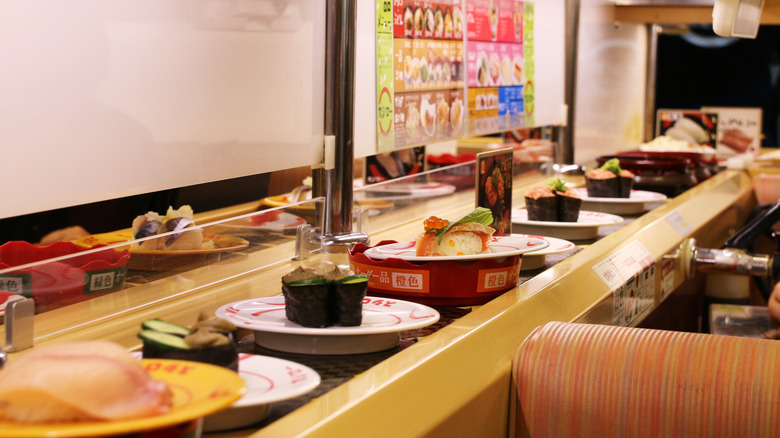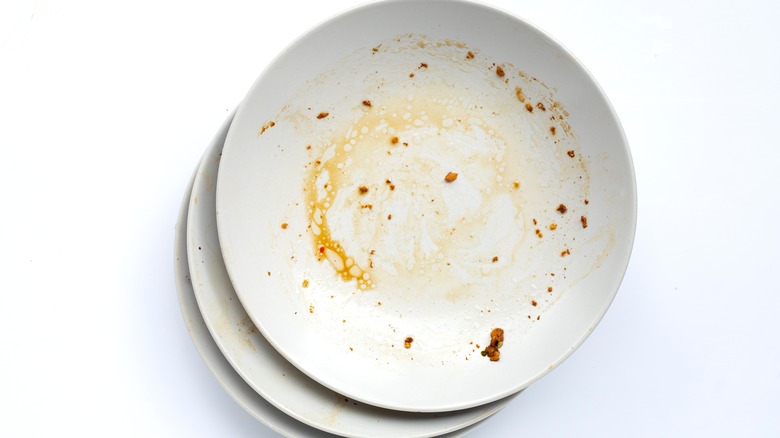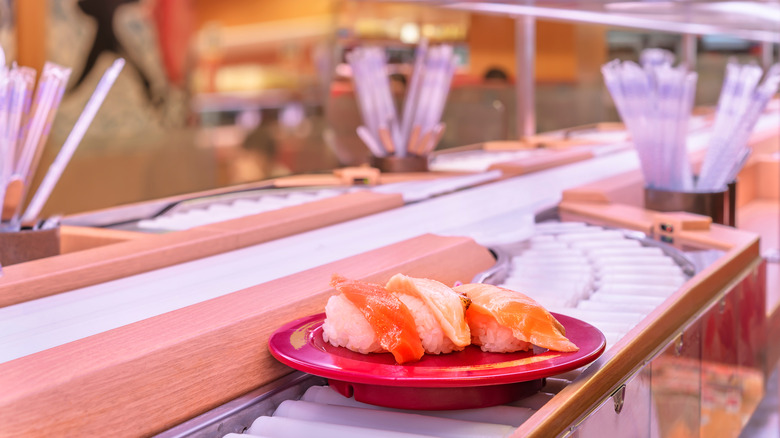The Etiquette Rule You Should Never Break With Conveyor Belt Sushi
You have your chopstick etiquette down to a T, have mastered the correct way to handle soy sauce, and you know your way around general sushi do's and don'ts. Now you're about to enter a kaitenzushi — aka a conveyor belt restaurant — and sit down for what's sure to be a wonderful meal, but did you know that there's an entirely different set of rules to be followed here, too? For instance, one of the most important things to be mindful of is knowing where to place empty plates. Hint: popping them back on the conveyor belt is never the answer.
Often referred to as the fast food of sushi, kaitenzushi is essentially a restaurant where a conveyor belt carries small plates of maki, nigiri, sashimi, and more through the entire establishment. Each plate will generally fit a piece or two of sushi, and diners get to pick whichever tickles their fancy by grabbing it from the moving belt.
However, once your plate is empty, it's best to keep it off to the side on your table rather than popping it back on the belt; doing so is considered bad manners and it's not very hygienic either.
Keep your empty plates right next to you
Bad manners and hygiene aside, there's another practical reason why you should never place soiled plates back onto the conveyor belt at a kaitenzushi restaurant. Because it's an automated and well-oiled operation that doesn't require a lot of staff or servers to function, this means that there is a system that diners must adhere to as well, and plates play a central role in this: They determine the final bill.
Some conveyor belt establishments will have a set price for all their sushi; here, plates aren't as significant. Other spots, however, use a system of colors or patterns on their plates to mark the prices of different varieties of sushi. Each restaurant may have its own coded system, which diners can see before they eat to keep track of their bill. But in general, a more intricate design is an indicator of a more expensive plate of sushi.
Stacking empty plates is an etiquette mistake at some restaurants, but kaitenzushi restaurants are an exception. When you're done with the meal, a server will come to count the pile of empty plates that you have on your table and will tally up the total bill based on the numbers, colors, and patterns. Placing soiled plates back on the conveyor belt hampers the counting, which means that you may be accused of being sneaky and tampering with your bill — even if it's entirely accidental. In fact, it's considered polite to stack your plates at the end of the table for the server, preferably categorized based on their color or pattern codes.
More conveyor belt sushi do's and don'ts
While there are rules to eating sushi properly, much of the etiquette at a conveyor belt sushi restaurant revolves around the use of plates and hygiene, as mentioned. These extra tips will help make the most of the experience for you and other diners.
For one, never touch anything that you don't plan to eat. These plates pass by all diners sitting at the restaurant, so it's important that everyone keeps their hands and utensils close to themselves to maintain proper hygiene. You can look closely to see whether you want to eat a certain piece of sushi but once you touch the plate, it would be impolite and unsanitary to put it back. Whether you choose to actually eat it or not is entirely up to you, but once you touch a plate, it's essentially yours.
Also, never pluck a piece of sushi straight from the conveyor belt — pick up the entire plate and transfer that to your table. Most restaurants also allow diners to place separate orders for sushi that isn't available on the belt. These orders will then be passed to the table through the conveyor in marked plates. Keep an eye out for your order if you place one, and don't pick up a plate that doesn't look like it's yours.



